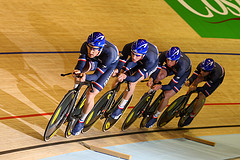At about this time last year, the Winter Olympics took place in Vancouver. In my country (the Netherlands) this is a very important event, being raised (or maybe even born if we think of Mark Tuitert, Ireen Wűst and Sven Kramer…) with speed skates on our feet. However, since it is also the year before the 2012 Olympicsin London, where cycling is an important event…it’s a nice time to focus on what we can learn from differences between cycling and speed skating.

Two of our papers on pacing and performance are in the February and March issues of BJSM. We studied (by combining modelling with experimental testing) the importance of pacing in both cycling and speed skating a 1500m distance. Our experiments showed that the best 1500m cycling performances were associated with a high mean power output and a fast start pacing strategy. In addition, using modelling techniques, we found that in all cases, cyclists were very well able to choose a close to optimal pacing strategy based on their ‘form of the day.’ Differences in mean power output were responsible for variations in performance.
In 1500m speed skating, this was different. In contrast to cycling, skaters were further away from optimal performance and there was room to improve performance by adjusting pacing strategy. Unfortunately, skaters who tried this did not succeed — they could perform a slightly faster start, but earlier fatigue associated with their fast start resulted in large consequences on technical aspects of the movement over the race. If speed skaters would succeed in dealing with the earlier fatigue associated with the fast start, models predict they would benefit of a faster start.
A perfect example of this was the Olympic race of Mark Tuitert, who performed the fastest start of all competitors, but was also able to deal with the premature fatigue in the second part of the race: He finished first and won the Olympic gold medal (watch race here).
It seems that cyclists have an adequate performance template on which they accurately adapt their pacing strategy based on their form of the day. It might be very important to develop and train this pacing template by experimenting with different pacing strategies. In speed skating, a cyclic movement largely influenced by technical aspects, there may be room for improvement by moving towards a faster start strategy on the 1500m distance. However, adequate training – that aims at dealing with fatigue over the second part of the race – is required.
Read full articles online now:
F.J. Hettinga, J.J. de Koning, M. Hulleman, C. Foster. Relative importance of pacing strategy and mean power output in self-paced cycling. Br. J. Sports Med. Published Online First: 22 october 2009.
F.J. Hettinga, J.J. de Koning, L.J.I. Schmidt, A.C. Wind, B. MacIntosh, C. Foster. Optimal pacing strategy: From theoretical modelling to reality in 1500-m speed skating. Br. J. Sports Med. Published Online First: 22 october 2009